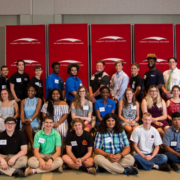Moving Toward the Regenerative Highway Corridor — Technologies and Implications for Workforce
Game-changing technologies in Transportation are on the way and a stretch of highway in Georgia is proving it with real-world pilot projects. The Ray is a proving ground for regenerative technologies along an 18-mile stretch of I-85, south of Atlanta. According to The Ray’s website, the goal for the highway is to become “net zero,” meaning zero deaths, zero waste, zero carbon, and zero impact. Today, there are seven active pilot projects on the site with another half dozen in the works for implementation over the next couple of years.
Solar Energy Generation
Solar power is a big part of the regenerative ecosystem being created, with multiple pilots of solar technologies in place or planned at the site.
In 2015, Georgia’s first solar-powered, photovoltaic-for-electric-vehicle charging station was installed.
 The first solar pavement pilot in the United States, called the Wattway was installed at The Ray in 2016. This is a 50-square-meter site with solar panels that are affixed to the existing roadway and support all types of vehicle traffic including fully loaded 18-wheel tractor-trailers. The solar energy that’s generated from the road surface is sent to the nearby Georgia Visitor Information Center.
The first solar pavement pilot in the United States, called the Wattway was installed at The Ray in 2016. This is a 50-square-meter site with solar panels that are affixed to the existing roadway and support all types of vehicle traffic including fully loaded 18-wheel tractor-trailers. The solar energy that’s generated from the road surface is sent to the nearby Georgia Visitor Information Center.
“The Georgia DOT is actually benefitting from the clean energy that’s being generated from the road surface via the Wattway when it is not shaded by a passing car or truck. It’s a little over a year old and has generated over 6.4 megawatt hours of energy during that time,” said The Ray’s Executive Director, Allie Kelly.
Georgia will become the third state to pilot right-of-way solar when a megawatt solar farm is built on the highway shoulder this year.
Solar panels can also be combined with other functional highway infrastructure. Research is being done on barriers that have solar panels attached.
Making Use of the Right-of-Way
Solar energy is not the only renewable resource being explored. Since 2016, the right-of-way along the highway has been used to grow a special type of perennial wheat grass that has deep roots that help retain water and sequester carbon. The straw from these plants can be used as an alternative to trees for products such as paper towels.
Other innovations in the utilization of the natural spaces around highways include the use of bioswales and pollinator-friendly plantings. A project tracking a series of bioswales—shallow drainage ditches filled with vegetation or compost that slow and clean water runoff—will help measure the impact this intervention has on water quality. A 7,000 square-foot pollinator garden has also been piloted at the visitor center located on the proving grounds.
A Better Road Surface
 Incorporating recycled tire rubber into asphalt to create a better road surface is another innovation being explored through the proving grounds. The resulting rubberized asphalt mix creates a more resilient, crack resistant, and quieter road surface with a useful life expectancy that is 15-to-20 percent longer than traditional asphalt. With the help of The Ray’s leadership, this innovative technology was brought to the attention of county and city leadership and was recently used on a neighboring stretch of road, the Tom Hall Parkway. That project presents a template that could be used in the coming years for a total repaving of The Ray.
Incorporating recycled tire rubber into asphalt to create a better road surface is another innovation being explored through the proving grounds. The resulting rubberized asphalt mix creates a more resilient, crack resistant, and quieter road surface with a useful life expectancy that is 15-to-20 percent longer than traditional asphalt. With the help of The Ray’s leadership, this innovative technology was brought to the attention of county and city leadership and was recently used on a neighboring stretch of road, the Tom Hall Parkway. That project presents a template that could be used in the coming years for a total repaving of The Ray.
Safety
Safety is a key component of The Ray’s mission. Work toward this goal began with a focus on under-inflation, the most common factor in tire failure, which is a significant cause of traffic fatalities.
In 2016, a UK innovation called WheelRight, was installed, which is an all-in-one tire safety station. To use, drivers simply pull their vehicle through the equipment at a low rate of speed. It is vehicle agnostic, working on school buses as well as sedans. The tests and analysis take about seven seconds, from start to finish, providing an evaluation of the tire pressure and the tire tread on all tires simultaneously, as well as an examination of the sidewalls.
Intelligent Transportation Systems
Coming up this year, The Ray is focused on smart road deployment with the goal of making it a route for connected and autonomous vehicles. Working with the Georgia DOT and a global data company, a pilot of connected vehicle technologies will work to improve the data analysis capabilities of traffic management centers.
Another pilot will focus on the changes needed in the infrastructure of the interstate to make it ready for autonomous vehicles.
“Instead of primarily working on the computer analysis, which is what the connected piece of this is about, the autonomous piece is about how to change the infrastructure so that autonomous vehicle systems, like computer vision, can operate most effectively and safely in that highway environment,” said Kelly.
How will Evolving Technologies Affect Workforce Needs?
As can be seen through the work being done at The Ray, with all the potential changes coming to highway infrastructure, the care and maintenance of transportation assets could also be greatly affected. This brings up interesting questions about how the Transportation field should be preparing the workforce for the future.
“Solar roads don’t need to be ground down or micro-milled. They don’t need to be crack-sealed, right? But, these are the things that are a part of routine maintenance with asphalt roads,” said Kelly.
How will processes for maintaining highways be impacted when the infrastructure is physically changed? What will this mean for the skills and expertise needed by the people responsible for its upkeep?
Some of these technologies take what has been a single-use asset, requiring time, money, and resources for upkeep, and turns it into a resource that can potentially generate income. What impact might this have on the overall business model?
“When you unleash single-use assets to operate in a variety of ways or to multi-task, DOTs should be poised to collect the revenue, the financial value, from that multi-tasking,” said Kelly.
Could the ownership of, or responsibility for, certain assets also shift with evolving technologies? With the potential of generating energy in the right-of-way, will this require the DOT to start behaving like a power utility? Or, conversely, will utility companies take on responsibility for highway assets?
“I wish it was a conversation that we were having as a nation because there is a transition that necessarily accompanies these technological advances in transportation,” said Kelly. “You are going to need people with the knowledge of renewable energy and electrical engineering to be involved in the maintenance of that kind of road.”






